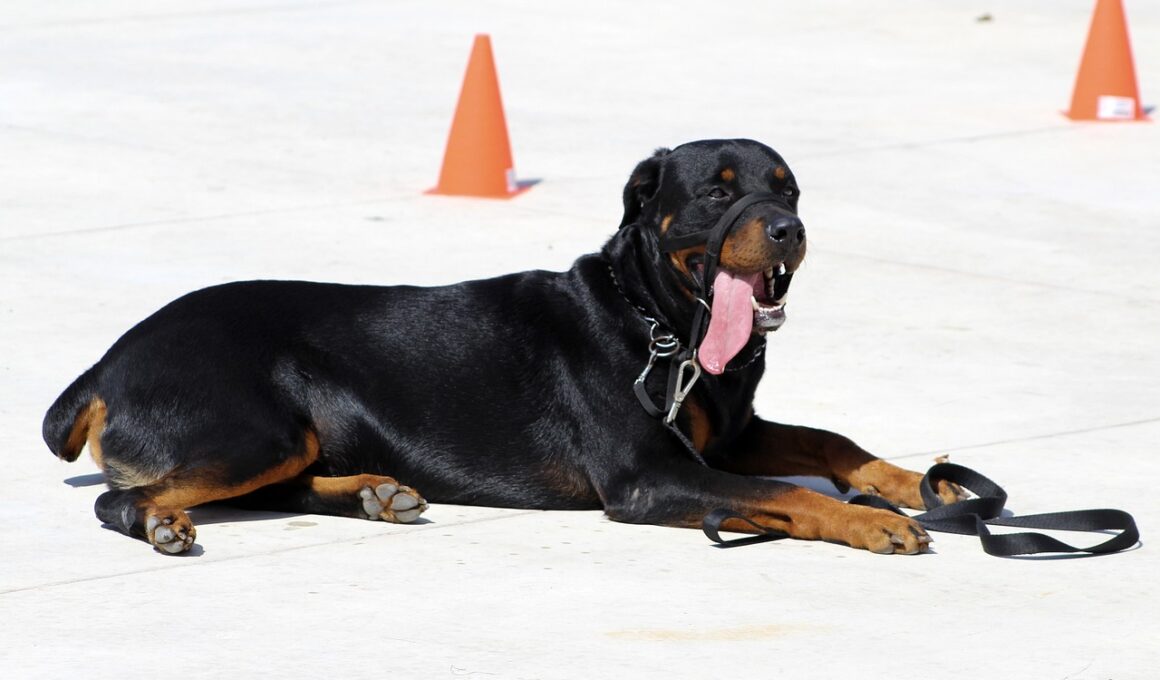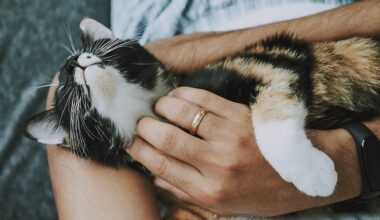Tailoring Training Techniques to Your Dog’s Breed
Training your dog for trick competitions requires a tailored approach based on your dog’s specific breed characteristics. Different breeds often exhibit varying levels of intelligence, energy, and eagerness to please. Therefore, understanding your dog’s breed traits is vital for effective training. For instance, Border Collies are renowned for their intelligence, which can be harnessed to learn complex tricks quickly. Conversely, breeds like Bulldogs may benefit from a more patient and gentle approach to training. It is essential to adapt your teaching methods to the individual dog’s personality traits. Achieving this tailoring might involve observing and evaluating your dog’s responses to various techniques. Use positive reinforcement strategies to encourage desired behaviors. Providing treats or praise can motivate dogs to perform tricks successfully. Additionally, consider the physical capabilities that come with each breed. Larger dogs might excel in tricks that involve strength, while smaller breeds could be better suited for agility. By catering to the specific attributes of your dog’s breed, training can become both efficient and enjoyable. Thus, always keep your dog’s characteristics and preferences in consideration during training sessions, ensuring the experience is beneficial for both of you.
When training various dog breeds for competitions, one significant factor is the age of your dog. Puppies are more adaptable and open to learning, often making them easier to train for tricks. However, older dogs can still succeed if approached with understanding and patience. Older dogs often have established behaviors that may need modification. Consequently, it is crucial to break down commands and tricks into manageable, clear steps. This gradual approach minimizes frustration for both you and your dog. Using clickers or verbal cues will aid communication during training sessions. Consistency in commands and idea training methods is paramount for engagement. Breeds with higher intelligence, like the Poodle, can grasp tricks faster, while more independent breeds may require a different style. It’s also important to factor in the endurance levels; some breeds may tire easily, while others thrive on continuous activity. Planning training sessions to align with your dog’s energy levels can greatly enhance learning outcomes. Moreover, keep sessions short and fun, focusing on enjoyable interactions rather than rigid schedules. Tailoring your approach based on your dog’s age will greatly influence performance in competitions and deepen your bond with them. Always celebrate small victories, no matter your dog’s age.
Incorporating Varied Techniques
Utilizing varied training techniques can cater to different learning styles and ensure engagement while preparing for dog trick competitions. Some dogs respond best to visual cues, while others thrive on verbal instructions. A mixed method can be beneficial. For instance, teaching a trick like “roll over” can begin with a hand gesture paired with a verbal command. Such an approach aids dogs in making connections between what they see and hear. Reward systems are also crucial in maintaining motivation throughout the training process. Options include treats, toys, or affection. With consistent use of rewards, your dog will learn to associate tricks with positive outcomes. To add excitement, introduce playtime or brief breaks during training. This burns off excess energy and keeps enthusiasm high. Group classes can also provide socialization opportunities that stimulate interest. Moreover, you can utilize distractions while training to enhance focus and discipline. Trying tricks in varying locations or incorporating new toys can create a dynamic learning environment. It’s critical to tailor your strategies to encompass the unique quirks of your dog’s breed. By combining various techniques and rewards and embracing their preferred learning modalities, competing dogs can excel in their performances.
Understanding the needs and motivations of different dog breeds is fundamental when preparing for trick competitions. Some breeds, such as the Golden Retriever, are known for their eagerness to please, making them enthusiastic learners. On the other hand, breeds like the Shiba Inu may require more incentives due to their independent nature. Recognizing that motivation affects every dog’s learning process will inform your training strategy. For instance, in working with the independent Shiba Inu, using food rewards may not always suffice. Instead, focusing on play or using their favorite toys can stimulate better engagement. Always assess your dog’s reactions to different types of motivation. Create a motivating environment that keeps your dog eager to perform. Setting realistic goals based on breed capabilities will prevent frustration. Celebrate achievements, big or small, to keep spirits high. Challenges, however, when approached correctly, can build resilience. Never force tricks onto any dog, particularly those less inclined; it can create aversion towards training altogether. Instead, be patient, allowing your dog to learn at their own pace. Gradually increasing difficulty and fostering a fun atmosphere will prepare them well for competition day.
Assessing Individual Dog Traits
Each dog possesses a unique personality that influences how they learn and perform tricks. Prioritize understanding these individual traits as it plays a pivotal role in training success. For example, some dogs may thrive under challenging tasks, while others may prefer simpler activities that boost their confidence. Thus, observing your dog’s reactions during training can guide your approach. Look for signs of stress or enjoyment to tailor your methods effectively. Engaging with your dog routinely in practice sessions can also help you bond and ensure they feel loved and secure during learning activities. To achieve the most productive training experience, consider the dog’s breed instincts. Herding breeds might find enjoyment in organized movements or agility tasks, while companion breeds may thrive on close interactions and gentle praise. Use positive reinforcement consistently, adjusting techniques based on the effectiveness of your training sessions. Incorporating play and fun into routines will promote a love for learning. Additionally, time of day and distractions can also impact training. Conduct sessions when your dog is calm and focused for optimal results. By honoring individual traits and preferences, you’ll enhance your bond, transforming training into an enjoyable experience for both of you.
Incorporating agility and fun while training your dog for competitions can significantly improve performance outcomes. Keeping training sessions light-hearted ensures the dog remains engaged and excited. In a light-hearted regime, tricks become a game rather than a task, encouraging dogs to express themselves freely. A well-structured training plan often includes a mix of fun and discipline, balancing serious learning with enjoyable activities. Active breeds particularly flourish in an upbeat learning environment where their natural instincts are harnessed. Incorporating play-related tasks into training routines can foster enthusiasm and alleviate boredom. Sessions can involve jumping over low obstacles, running through tunnels, or even playing tug-of-war. Each playful interaction builds confidence while teaching essential skills. Training should not be purely formal; allow freedom for exploration and improvisation. Consistency is crucial, but remember that enjoying the process holds long-term results. Be mindful of your dog’s responses; engaging in activities they like strengthens your bond and facilitates learning. Moreover, giving choices during training can enhance your dog’s motivation to participate. By merging agility and play into training routines, you hold the power to create a vibrant, competitive spirit within your dog.
Strengthening the Bond
Strengthening the bond with your dog during trick training can lead to greater success in competitions, as dogs thrive in environments where they feel secure and loved. This sense of trust allows for deeper communication, improving both the learning experience and the bond itself. One way to accomplish this is through praise and play. Recognize progress, regardless of how minor the advancements may seem; consistent acknowledgment encourages them to continue striving for success. Moreover, implementing training sessions that suit the breed’s likes fosters a positive environment. For example, working with a Labrador Retriever can involve water games, enhancing the training experience tailored to their natural instincts. Taking breaks for cuddles or relaxation can also reinforce the bond while ensuring they feel appreciated and understood. Additionally, consider varying training routines to include family or friends so that your dog sees interactions as opportunities. This not only enhances socialization but creates engagement linked to competition preparation. Lastly, practice patience and take the time to increase resilience; hurdles often arise in learning. By putting in the effort to strengthen your bond with your dog, you will notice improvements in their motivation and skills leading up to competitions.
Participating in dog trick competitions can become a joyful adventure that deepens your connection with your dog. Understanding how to design tailored training techniques based on breed characteristics enhances both engagement and performance, resulting in rewarding outcomes. Strive to create an environment where learning remains enjoyable and built on mutual respect. Always remember that each dog is distinct; patience is essential in adapting methodologies to resonate with individual traits. Combining varied strategies, motivation techniques, and recognizing each dog’s physical capabilities allows you to structure more effective training plans. Encourage an atmosphere of positivity with consistent praise, mindful of your dog’s reactions and energy levels. Training shouldn’t feel like a chore, but rather an opportunity to bond deeply. Make sessions fun and encourage agility play while establishing routines. Celebrate improvements, regardless of size, and measure success against personal growth rather than competition alone. By fostering a collaborative spirit, both dog and handler gain invaluable experiences. Ultimately, trick training should blend skill development with love, enriching the lives of both handler and dog. As your dog takes center stage in competitions, the connection forged through tailored techniques and training becomes the true victory shared during every performance.


